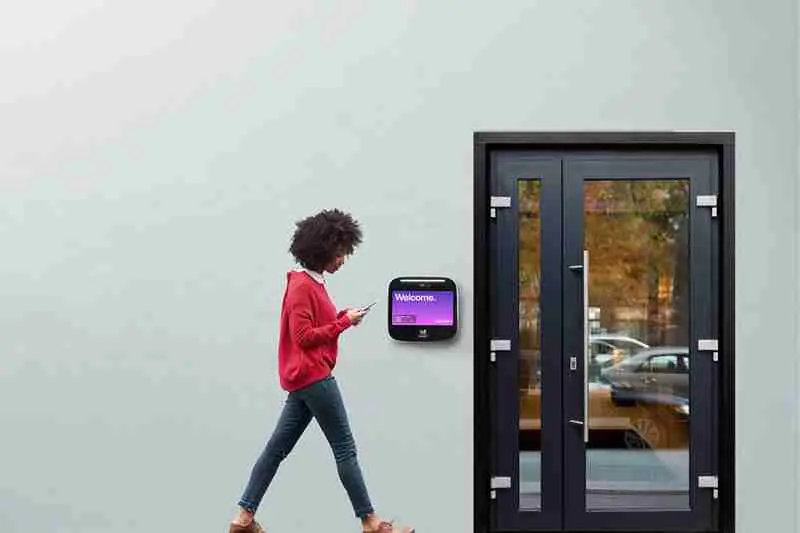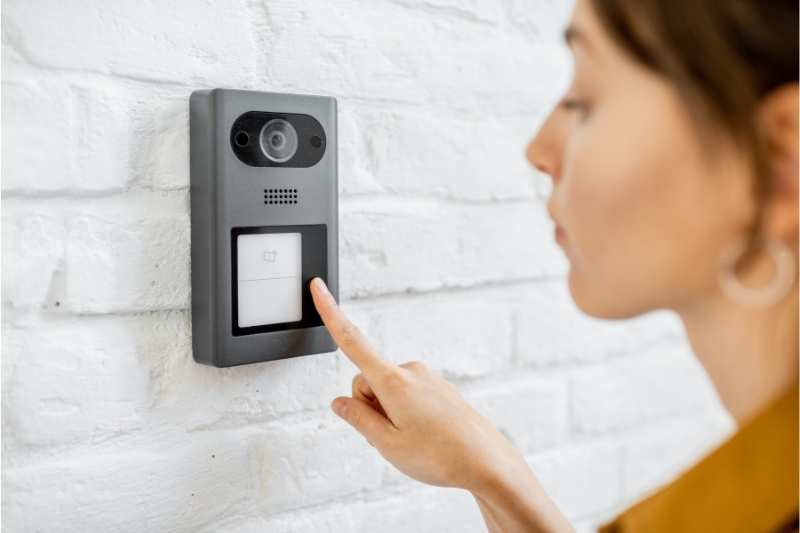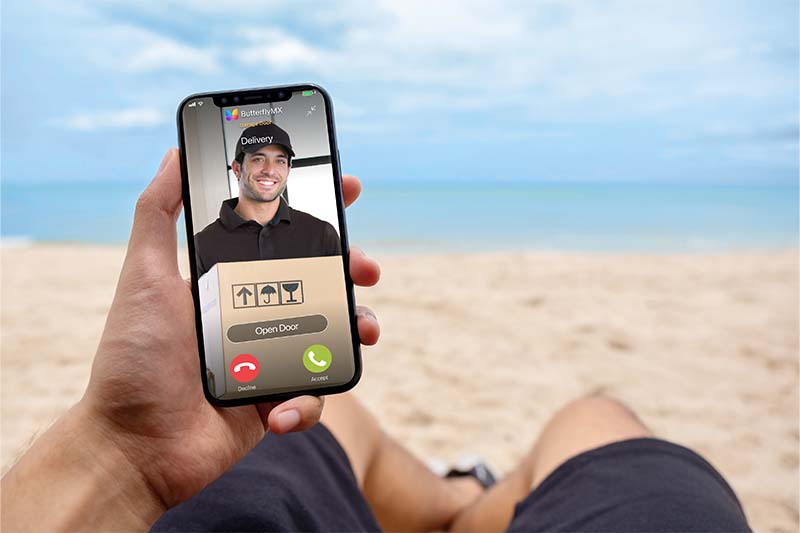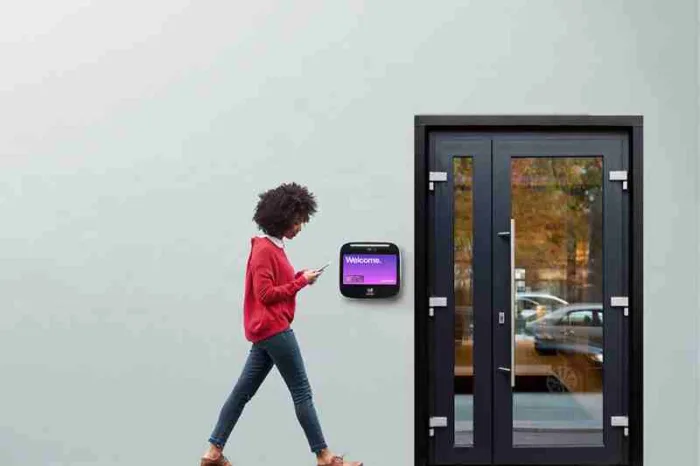Key takeaways
- Most modern intercom systems are wireless because they’re easier to install and require minimal wired connections.
- A wireless video intercom is a door entry system with a video-calling camera.
- Wireless intercoms transmit audio and video signals to substations through cellular signals or the Internet.

If you’re in the market for a building entry system, you’ve probably encountered a lot of different options. From video intercom systems to door buzzers to telephone entry systems, there are countless options out there. However, one system stands out from the rest: the wireless video intercom.
In this buyer’s guide, you’ll first discover the best wireless video intercom and its many features. Then, you can learn more about what these systems are and how they work. Finally, you’ll find the advantages wireless intercoms are capable of providing.
Navigate this post:
- What is the best wireless video intercom system?
- Can an intercom be wireless?
- What is a wireless video intercom system?
- How does a wireless intercom work?
- What is the advantage of a wireless intercom system?
Watch how the ButterflyMX ecosystem works:
What is the best wireless video intercom system?
Established in 2014, ButterflyMX’s flagship product, the wireless video intercom, has been installed in over 15,000 buildings and has more than one million daily active users. With over 40,000 five-star reviews, it’s one of the most trusted video intercom systems on the market.
The ButterflyMX video intercom is a wireless, cloud-based system that enables tenants to use their smartphones for access. As for property managers, you can use the mobile app or web-based dashboard to edit permissions, view audit logs, and integrate with your third-party software. Whether you’re on-site or at another property, property managers or owners can easily manage access to the property from anywhere.
Of course, ButterflyMX encompasses a wide range of beneficial features for both property managers and tenants.
ButterflyMX wireless video intercom features:
- Cloud-based. Cut down on installation costs and enjoy your video intercom for longer thanks to its cloud-based technology. The ButterflyMX video intercom doesn’t require in-unit hardware, so installation is much faster and more affordable than its wired counterparts.
- Mobile app. The ButterflyMX mobile app allows users to manage user access, review past entries, and integrate with property management software. Meanwhile, tenants can grant access for themselves or remotely to their guests, delivery drivers, and service providers using their smartphones.
- Built-in camera. See who you’re speaking to with a built-in camera that enables two-way video calling. Residents and property staff feel safer when they can see who requests access at the entryway.
- Multiple credentials. Access the property in more ways than one. The ButterflyMX wireless video intercom supports mobile access, PIN codes, and Visitor Passes for guests and delivery drivers.
- Delivery solutions. Give major couriers access to the property using ButterflyMX deliver PINs. This feature allows couriers like Amazon, FedEx, USPS, and more to access the property independently. As a result, residents receive their packages without delay.
- Integrations. ButterflyMX’s integrations allow you to centralize all of your property’s software and hardware in one place. The ButterflyMX video intercom integrates with a wide range of PMS and security hardware to provide a comprehensive solution.
- ButterflyMX ecosystem. Benefit from the entire ButterflyMX ecosystem with its vast range of solutions, such as elevator controls, vehicle readers, access control, and more. Most importantly, all of ButterflyMX’s products integrate seamlessly, allowing for simple management on one platform.
How much does ButterflyMX cost?
The ButterflyMX wireless video intercom is available in 8” and 12” sizes, starting at $3,995 and $5,995, respectively.
In addition to hardware costs, ButterflyMX charges per unit for software and hosting services. Thus, you can expect to pay between $30 and $42 per unit annually. However, costs will vary based on features, integrations, and additional hardware.
Lastly, these costs do not include installation. Nonetheless, our team will help you locate a certified installer in your area to ensure your system maintains its two-year warranty.
Can an intercom be wireless?
Yes, an intercom system can be wireless. Most modern video intercom systems utilize the cloud to eliminate extensive wiring to individual units.
While wireless door video intercoms appear to be wireless, they are usually not entirely without wires. These systems require a few simple connections, including a power source, an internet connection, and a door strike.
Because of these few wires, installation is simple, and the intercom is more dependable. After all, wireless internet connections can be unstable. So, a direct connection provides peace of mind for property managers and owners.
What is a wireless video intercom system?
A wireless video intercom is a door entry system with a built-in camera for video calling that doesn’t require physical wiring between the system’s hardware. The system wirelessly transmits audio and video footage when a resident and a visitor communicate. It also provides a way for residents to open the door or gate for their guests. It often relies on an internet connection.
Video intercom systems offer either:
- One-way video calling. During a video call, a resident can see visitors on their device’s screen, but visitors can’t see the resident from the outdoor station.
- Two-way video calling. Residents and visitors can see each other during a video call.
What is the difference between a doorbell and an intercom?
A doorbell differs from an intercom because it is an alert system that doesn’t allow for two-way audio communication between a resident and a visitor. Most intercom systems with in-unit hardware have a buzzer that alerts a resident to their control panel. Many residential buildings will have an intercom system for the whole building and individual doorbells at the door to each unit.
A wireless video intercom simplifies both systems with the added benefit of a camera and other features.
How does a wireless intercom work?
A wireless intercom transmits audio and video to tenant substations. The method of transmission depends on the system, but the most common include the Internet and cellular signals. In either case, the wireless intercom uses various components to fulfill its task.
Every video intercom system requires a base station at the property’s entrance. This hardware contains the resident directory, which visitors use to find a tenant. The base station also has a speaker, microphone, and camera.
Wireless intercom systems also need substations, which are the devices residents use to answer visitors’ calls. Finally, wireless video intercoms have a door release mechanism, which empowers residents to unlock the door or gate remotely.
There are two types of wireless video intercoms:
- Systems with in-unit hardware. A video intercom with in-unit hardware requires you to install substations in every unit throughout the building. These substation devices contain a microphone, speaker, and sometimes a camera. The devices communicate wirelessly with the intercom base station.
- Smartphone-based systems. Instead of requiring in-unit hardware, these video intercoms operate with residents’ smartphones. Residents download a mobile app, which they use to answer video calls and open the door remotely.
What is the difference between doorbell and intercom?
A doorbell differs from an intercom because it is an alert system that doesn’t allow for two-way audio communication between a resident and a visitor. Most intercom systems with in-unit hardware have a buzzer that alerts a resident to their control panel. Many residential buildings will have an intercom system for the whole building and individual doorbells at the door to each unit.
A wireless video intercom simplifies both systems with the added benefit of a camera and other features.

What is the advantage of a wireless intercom system?
The advantages of a wireless intercom system include increased security without sacrificing convenience for tenants and staff. Intercoms with cameras, integrations, and other features also provide many benefits.
With that said, here are a few advantages of choosing a wireless video intercom system:
- Increased property security
- Attract and retain residents
- Never miss a visitor or delivery
- Affordable installation
1. Increased property security
Nobody wants to live in an unsafe building. So, you need a device that will improve security.
A wireless video intercom with door release at your front entrance lets you lock the door or gate without hampering access for residents, guests, and delivery carriers. The intercom system prevents access for anyone who shouldn’t be there while providing an easy way for visitors to request access.
Additionally, the video component adds an extra layer of security. Video calling allows residents (and property staff) to confirm who’s requesting visual access. That way, they can monitor who they’re letting in before opening the door.
Pro tip: Choose a wireless video intercom that takes a photo of every door and gate release event. The property staff can monitor this audit trail at their convenience to maximize security. Cameras can also help deter criminal activity; they don’t have to be security cameras.
2. Attract and retain residents
A wireless video intercom benefits your bottom line as a developer, owner, or property manager.
Tenants expect a reliable door entry system anywhere they live. Adding a video intercom system means you’re not just meeting residents’ expectations — you’re exceeding them.
A video intercom doubles as an apartment amenity because it:
- Ensures successful package deliveries.
- Empowers residents to open the door from anywhere.
- Lets residents create Visitor Passes for guest access.
- Eliminates the need for physical keys.
Adding this convenience- and safety-focused amenity’ll better attract and retain residents, maximizing your NOI (net operating income).

3. Never miss a visitor or delivery
Everyone can relate to the frustration of missing a package delivery or an unplanned guest. Fortunately, a wireless video intercom ensures that staff and multiple tenants can always grant access to couriers and visitors from anywhere.
With a video intercom system, you’ll say goodbye to package theft and those pesky “Sorry we missed you” notes. Delivery carriers can use the intercom to get inside the building and safely leave packages instead of dropping them off at the front of a gate or doorway.
A wireless video intercom also ensures access support for dog walkers, service providers, and friends dropping by to say hi.
For example, even if a resident isn’t home, they can answer video calls from visitors and unlock doors right from their smartphone. This eliminates the need for residents to continuously monitor their intercom.
4. Affordable installation
You know your apartment needs an effective door entry solution, but you might be concerned about the cost of installing a new system. Not to worry: Wireless video intercoms don’t require expensive wiring, so they’re cheaper to install than a wired system.
If you purchase a wired intercom, you must pay for all the wiring to connect the device. On top of that, installers charge more to install wired systems since they have to break down walls and pavement to lay all the wiring. In contrast, wireless intercoms have the advantage of only requiring you to install the hardware at doors and gates.
Pro tip: Choose a video intercom system without in-unit hardware. That way, you’ll avoid the cost of purchasing, installing, and maintaining hardware. Since residents use their smartphones with the intercom, it won’t cost anything.

Get your free quote!
Fill in the form below, and we'll email you right back.
Want a free quote?
Fill in the form below, and we'll email you right back.
You’ll be redirected shortly...





